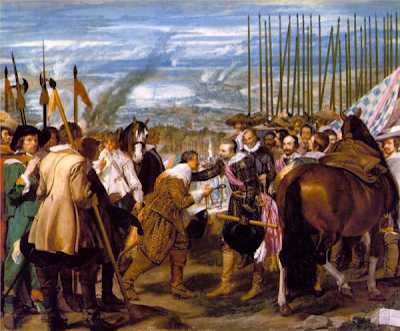War Painting and Painting War
Weekendavisen - a Danish weekly paper - writes today of a new war painting on the Danish participation in the Nato mission in Libya in the autumn of 2011, when Gaddafi was toppled from power. The painting was meant to be part of a commission on a series of battle paintings, intended to renew the genre in our day and age.
From then on all went sour. The artist made different choices than the expected ones and the two commissioning parties deny who said what or even had the idea first. The story is not mentioned here to put the blame on anyone, the arguments are only too familiar. The very same positions, oppositions and plenty use of waiving are used every time. The expectations are high and have to be met, there are facts to be kept, such as getting the weapons right and then there is the fictional part. For one thing, victories are seldom clear entities outside of their narrative frames and so the commissioned artwork has to be cut to fit into said frames. It is a mise en scène, which all parties have to have in mind if the painting process shall have a positive end result. We have of course the magnificent examples from the past. Velázquez' portrayal of the handing of the Breda town key to the Spanish general ten years earlier, not least. We have before us a clear cut winner in front of a sweeping landscape, his art of weaponry is presented and the oversized, mighty beast of the general's horse is ready at hand. He might as well be mounted on its back hovering above everyone.
Everything is crammed into the picture plane and yet it works because of the artistic energy binding the narrative elements together to a whole while still letting each element seem to have a life on its own. Just take the two horses, the winning and the losing one whose gazing at each other adds another cross line to the composition and thus an added layer to the narration of the whole. The losing horse mimics the soldier in green, both confronting us from the losing side making sure that we stand humbly before such splendor:
 |
| Diego Velázquez, The Surrender of Breda, 1634/35, Museo del Prado. |
In Velázquez each detail is added for a reason and to the greater whole. This was made all the easier by the fact that the general, the ruler and the winner was said to be the one and the same. In the present Danish case - which so far remains unseen outside the persons involved who now only corresponds through their lawyers - both the Libyans and the Danish planes should be celebrated as winners. Only that already constitutes two scenes, one from a bird's eye perspective which invariably caused civilian losses on the ground, which of course was a no go in the negotiations...
A classical case of "… and then there must be… and that too… and absolutely this, nothing without this, but oh no, we can never have that" to which any cartoonist will nod in sorrowful recognition.
And one thing: When the artist has been allowed the final word, those are the works we remember afterwards. The artist condenses all the ingredients and transforms it into a whole, such as Ammar Abu Bakr did yesterday on the corner of Mohamed Mahmoud Street: The military, their arms, the victims, the moral winners, the ones remembered and what and why has taken place. Not a thing of this is to be seen figuratively speaking and yet it is all there and all the more:
 |
| Ammar Abu Bakr, Bassem Mohsen at the corner at Mohamed Mahmoud Street, Photo: Mo ElMalt, January 3, 2014. - the blind eye still under way here. It has turned into a luminescent giant's eye... |
Bassem Mohsen died on December 22, 2013. He was shot three times when taking part in pro-Morsi Marches, even if he did not belong to either side of the present conflict. Both sides are blaming the other for his murder. He lost one eye in the Mohamed Mahmoud-clashes November 2011 and thus came to embody what has taken place since 2011 in Egypt.
The mural is an opinioned voice as any battle painting has always been, this one at not just the heavily symbolical street, but at the corner leading to it so that his eye fixates us from a long distance and all the stronger so the longer distance as Mo ElMalt's photo shows below. An eye and a voice in the middle of a conflict, but then we are always in the middle of it all. Beginnings and endings belong to the fictional world.
 |
| Ammar Abu Bakr, Bassem Mohsen at the corner at Mohamed Mahmoud Street, Photo: Mo ElMalt, January 3, 2014. |
Oh, and it is shameful even to think of any Danish discussion on planes and soldiers and… when seeing what Libya has to show us. A month ago Ammar Abu Bakr included the very same elements of strength, danger, change and yet the running blood forming the colors of the flag on Human Rights Day 2013. Note the scale of the mural against its artists, it is Ammar Abu Bakr standing on the ground:
 |
| Ammar Abu Bakr, mural on Human Rights Day 2013 in Libya, Photo: Aude Thep, December 10. 2013. |
Psst, Per Marquard Otzen... Per, knowing the cartooning intellectual, you would probably even include the lawyers in a take on the Danish battle painting?
- The artworks shown are courtesy of their respective artists and photographers and must not be reproduced without their permission.

